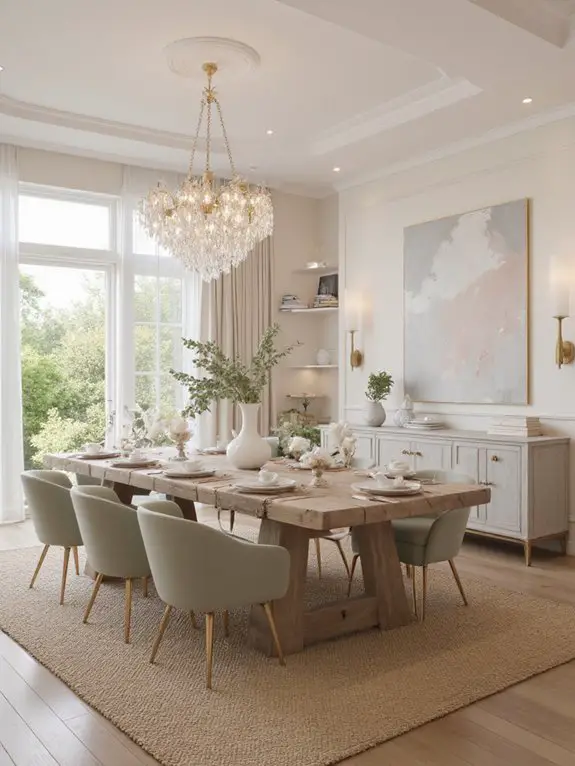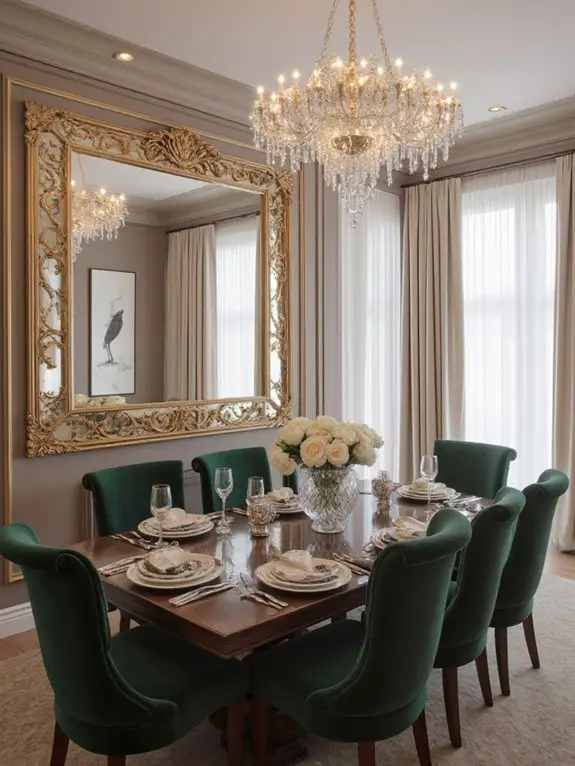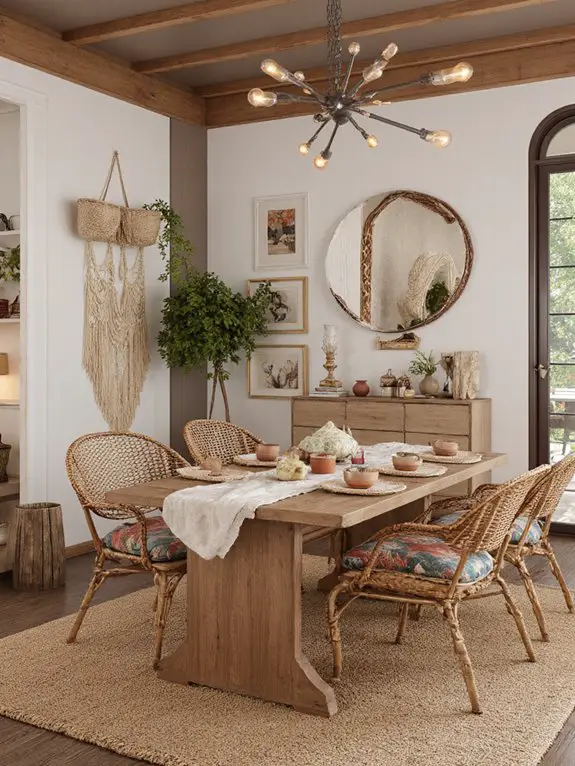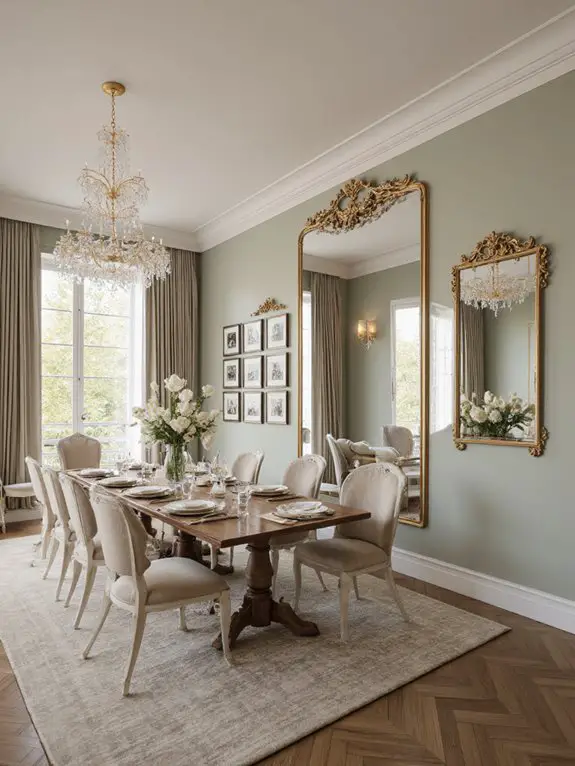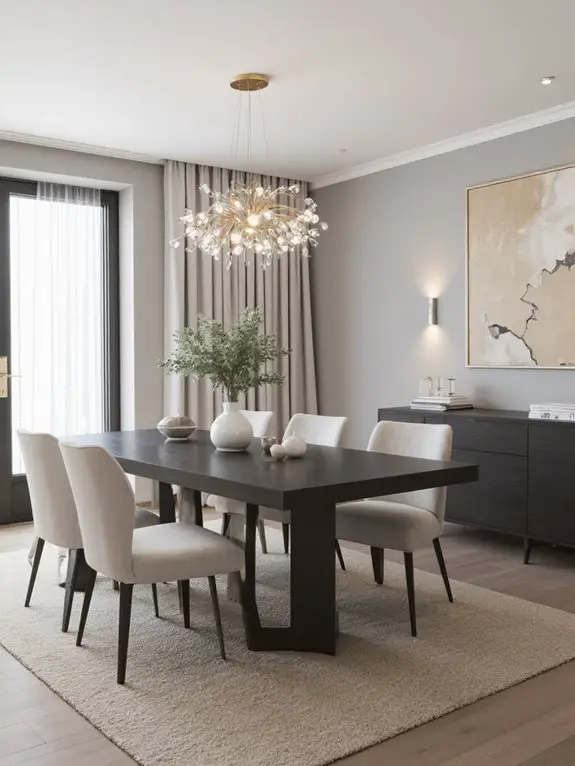I’ve found that simple updates can transform a dining room without a full renovation. Start with a statement chandelier hung 30-36 inches above the table for ideal lighting. Layer a bold rug underfoot and mix chair styles for personality. Fresh flowers or a low centerpiece add life, while artwork or a large clock anchors the wall. Refinish your table for a fresh look—neutral tones stay timeless. There’s plenty more to explore for a polished space.
Add a Statement Light Fixture
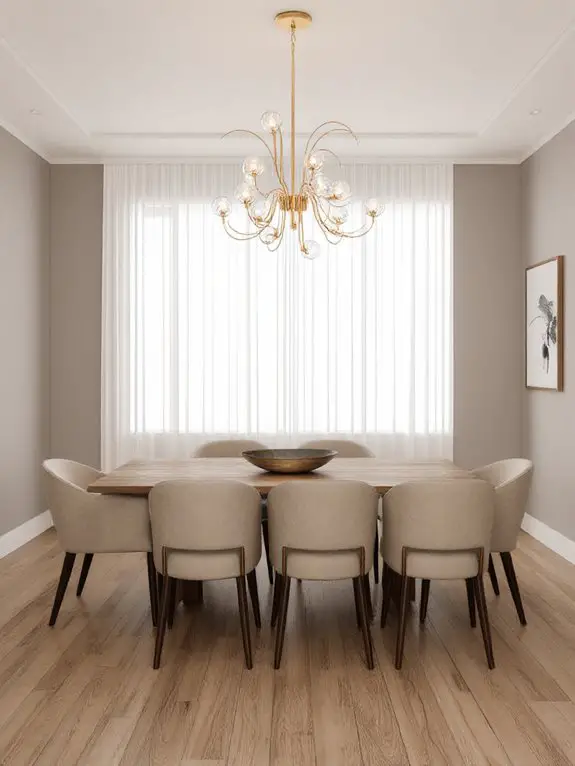
Transform your dining room by adding a statement light fixture that instantly elevates the space. I’ve found that a chandelier or pendant light creates a focal point while enhancing the room’s ambiance.
When choosing a fixture, I consider the size of my table and ceiling height—oversized designs can overwhelm, while too-small ones get lost. I opt for materials like brass or glass to add texture and reflect light.
Warm bulbs create inviting tones, perfect for meals. I also verify the fixture hangs 30-36 inches above the table for ideal proportions.
This simple upgrade makes my dining space feel polished and intentional.
Incorporate a Bold Rug
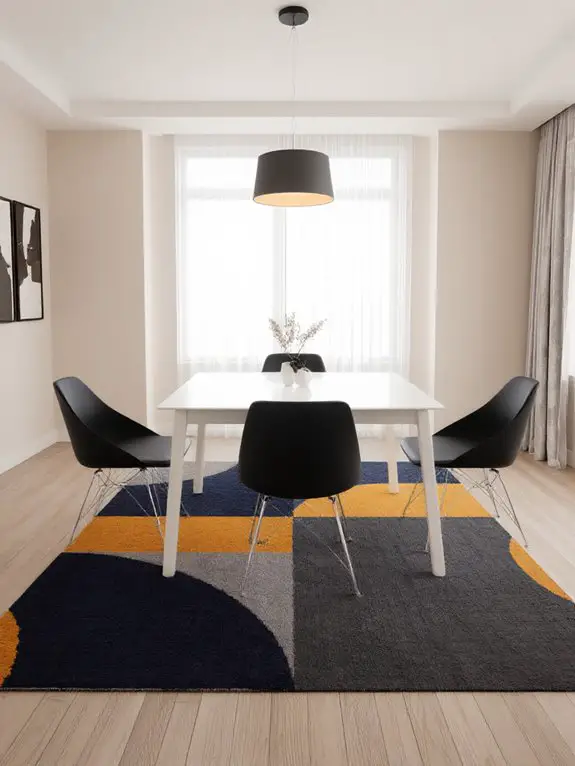
A bold rug can anchor your dining room, giving it a cohesive and intentional look. I recommend choosing a rug with a striking pattern or vibrant color that complements your existing decor while making a statement.
Opt for a size that extends beyond the table and chairs, allowing the rug to define the space. Materials like wool or synthetic fibers are durable and easy to clean, making them ideal for dining areas.
A bold rug not only adds visual interest but also softens the room’s acoustics, creating a more inviting atmosphere for meals and gatherings.
Use Unique Chair Designs
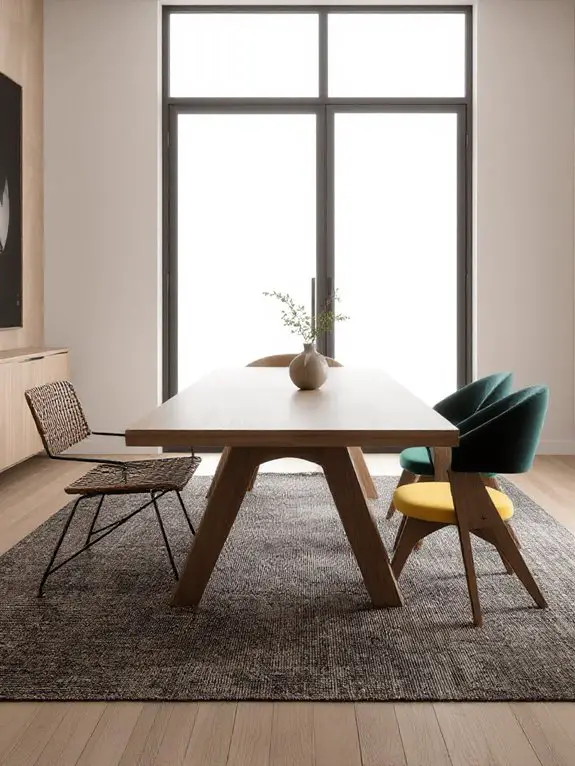
While dining tables often take center stage in a room, it’s the chairs that can truly elevate your dining space with personality and functionality.
I like to mix and match chair designs to create visual interest, such as pairing upholstered chairs with sleek, modern ones. Vintage or antique chairs can add character, while bold colors or patterns make a statement.
Comfort is key, so I guarantee the chairs are ergonomic and supportive for long meals. Even swapping out one or two chairs for something unexpected, like a bench or bar stool, can transform the look while maintaining practicality.
It’s about balancing style and function.
Hang Artwork Above the Table
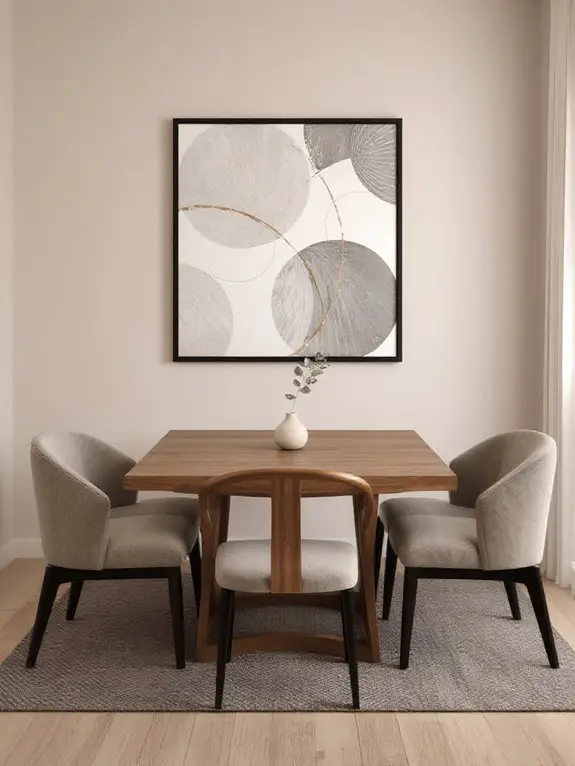
To anchor your dining space with a focal point, I recommend hanging artwork above the table—a technique that ties the room together while reflecting your personal style. Choose a piece that complements your color scheme and fits the scale of your table; it shouldn’t overwhelm or underwhelm the space.
A large painting, a framed print, or a cohesive series of smaller pieces all work beautifully. Hang it at eye level, typically about 60 inches from the floor to the center of the artwork, ensuring it’s visible while seated.
This addition elevates the room’s ambiance, making meals feel more curated and intentional.
Introduce Fresh Flowers or Plants
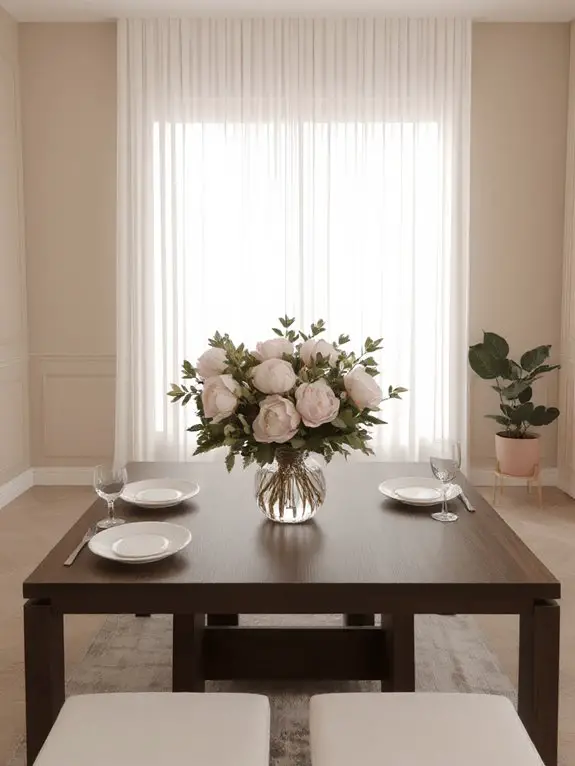
Adding fresh flowers or plants to your dining room instantly breathes life into the space, creating a vibrant and inviting atmosphere. I’ve found that even a simple vase of seasonal blooms on the table or a small potted plant on a sideboard can transform the room.
Opt for easy-care options like succulents or ferns if you’re not confident with upkeep. I also love using flowers that complement my decor’s color scheme to tie the look together.
Fresh greenery not only adds visual interest but also brings a sense of calm and natural beauty, making meals feel more special.
Layer Table Linens
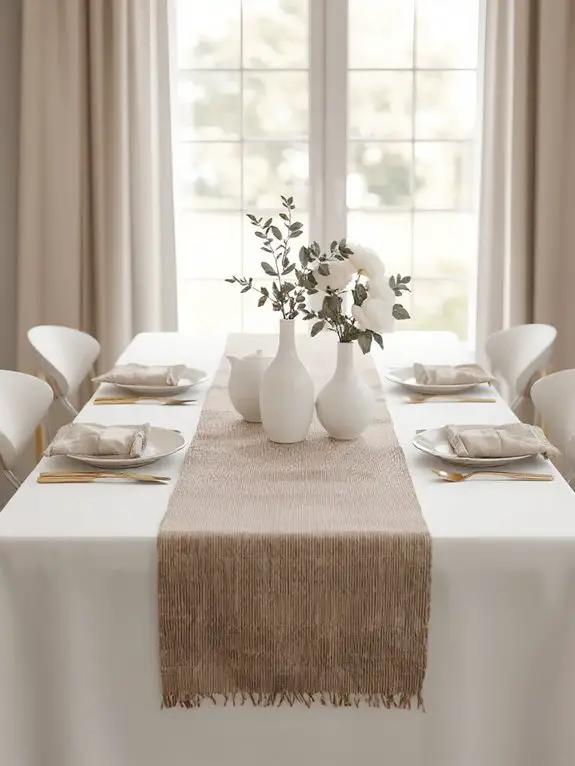
Layering table linens is a simple yet effective way to elevate your dining room’s aesthetic while adding texture and depth to the table setting. I start with a neutral tablecloth as the base, then add a runner or placemats to introduce color or pattern.
Mixing fabrics like linen, cotton, or burlap creates visual interest. I often fold a smaller cloth or napkin diagonally and place it under the centerpiece for a polished touch.
Don’t shy away from combining different textures—smooth and coarse materials can complement each other beautifully. This approach not only looks refined but also allows for easy customization.
Experiment With Tableware
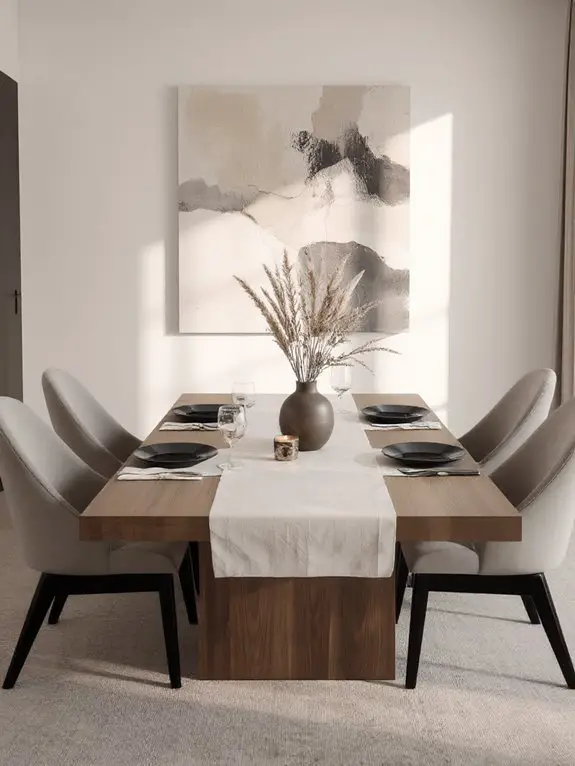
While tableware might seem like a functional necessity, it’s also a powerful tool for transforming your dining room’s vibe. I’ve found that mixing and matching plates, bowls, and glasses can create a dynamic and personalized look.
Try pairing bold, patterned dishes with neutral chargers for contrast, or use vintage silverware to add a touch of elegance.
Don’t be afraid to play with textures, like opting for matte finish ceramics or metallic accents. Even small changes, such as swapping plain glasses for hand-blown or colored ones, can make a big impact.
Experimenting with tableware is an easy way to refresh your space.
Install Floating Shelves
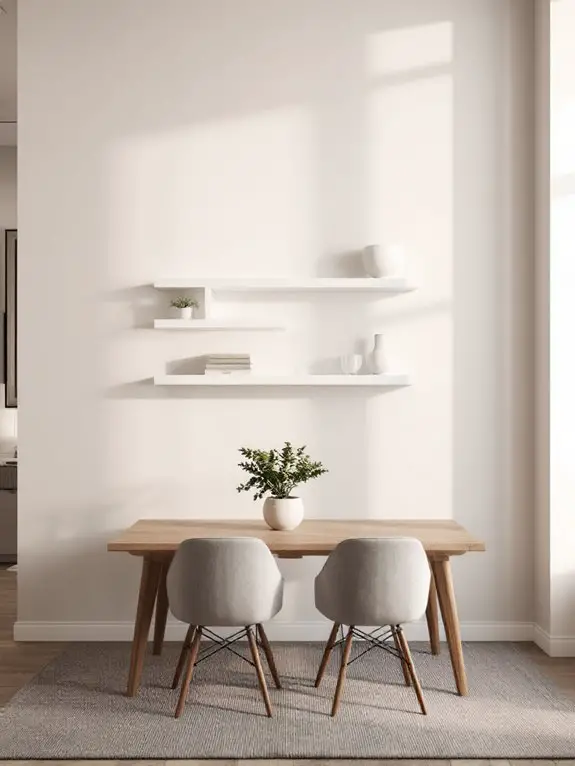
When it comes to maximizing space and adding functional decor to your dining room, floating shelves are a game-changer. I’ve found they’re perfect for displaying decorative items like vases, framed photos, or small plants without cluttering the table.
Mounting them at eye level keeps the dining area open while drawing the eye upward. I recommend choosing shelves that match your room’s aesthetic—wood for warmth or metal for a modern edge.
Be mindful of weight limits and avoid overloading them. Adding a few carefully curated pieces creates a polished look without overwhelming the space, making the room feel both stylish and practical.
Opt for a Buffet or Sideboard
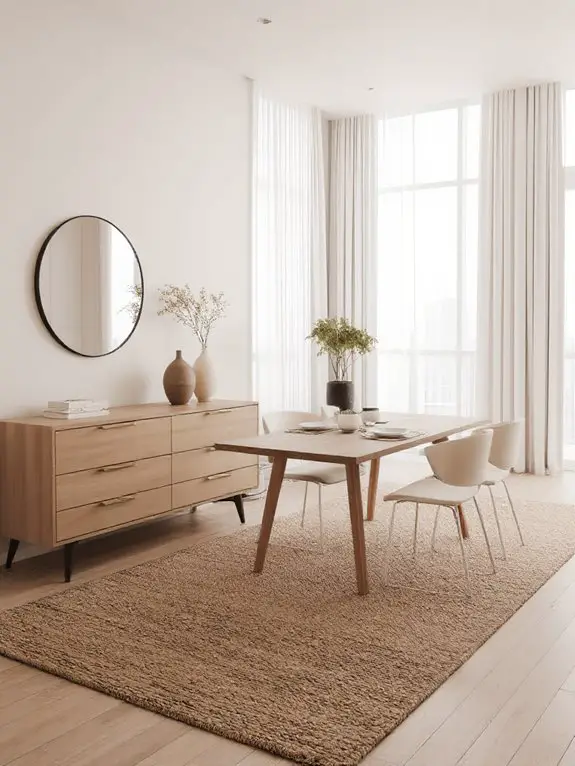
To add both functionality and style to your dining room, I’d suggest incorporating a buffet or sideboard. These pieces not only provide extra storage for dinnerware, linens, or serving dishes but also create a polished, grounded look.
Choose one that complements your table and chairs, ensuring the materials and colors harmonize with your overall decor.
A buffet can double as a serving area during meals, while a sideboard offers a surface for decorative items like vases or framed photos.
Look for options with drawers or cabinets to keep clutter hidden, maintaining a clean and inviting space for dining and entertaining.
Use Mirrors to Reflect Light
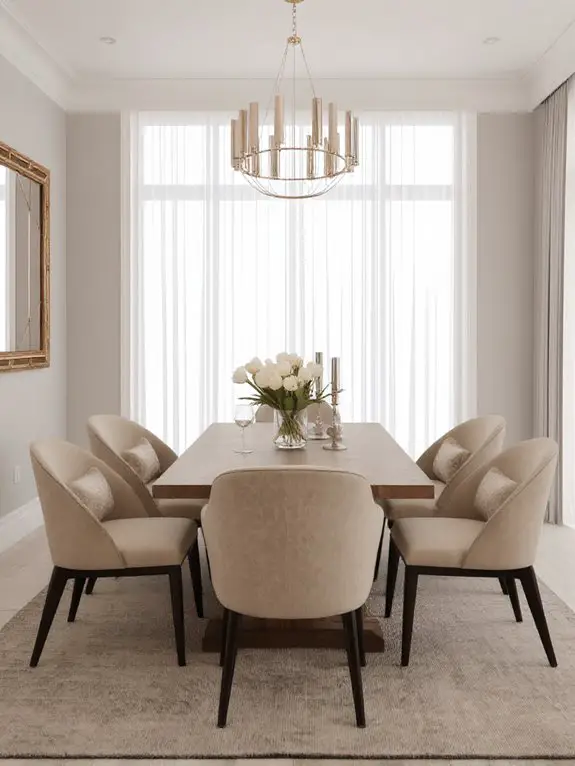
Mirrors can completely transform the ambiance of your dining room by amplifying natural light and creating a sense of spaciousness. I love placing a large mirror opposite a window to bounce sunlight around the room, making it feel brighter and more inviting.
If your space is small, a mirrored wall or strategically placed mirrors can trick the eye into perceiving depth. Choose frames that complement your decor—sleek metals for modern spaces or ornate wood for traditional settings.
Just avoid cluttering the room with too many mirrors; one or two well-positioned pieces will do the job beautifully.
Change Out Dining Room Curtains
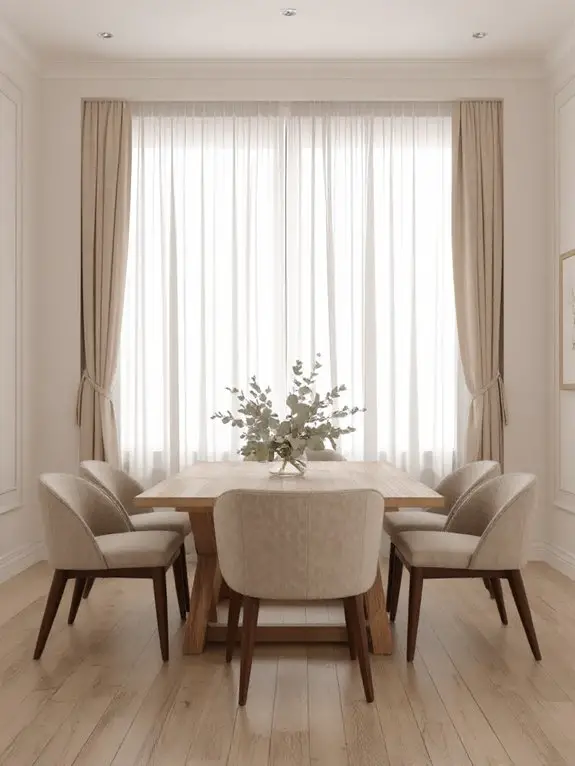
Since curtains play a significant role in defining the mood of a dining room, I’ve found that updating them can make a noticeable difference in the overall aesthetic. Start by considering the fabric—lightweight materials like linen or cotton create an airy, casual vibe, while heavier options like velvet or blackout curtains add elegance and warmth.
Next, think about color and pattern. Neutral tones keep things timeless, while bold hues or prints can inject personality.
Don’t forget length—floor-length curtains lend sophistication, while shorter ones feel more relaxed. Finally, experiment with ties or decorative rods to enhance the look without overwhelming the space.
Add a Pop of Color With Accent Walls
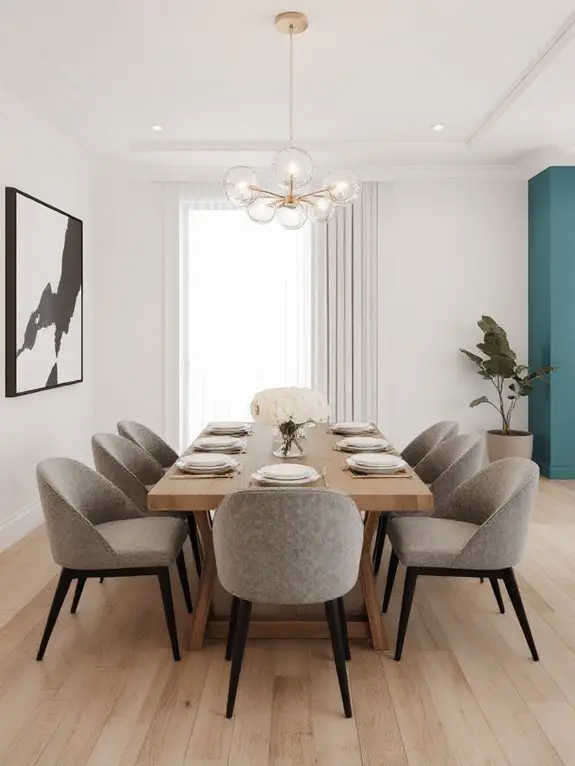
While curtains can transform a dining room’s ambiance, accent walls offer another way to elevate the space with bold personality. I love how a single painted wall can become the focal point, adding depth and character without overwhelming the room.
Choose a color that complements your existing decor—deep blues, rich greens, or even a warm terracotta can create a striking effect. For a more subtle approach, opt for textured finishes like lime wash or sponge painting.
I always recommend testing paint samples in different lighting to confirm the shade works throughout the day. It’s a simple update that makes a big impact.
Display a Collection of Plates
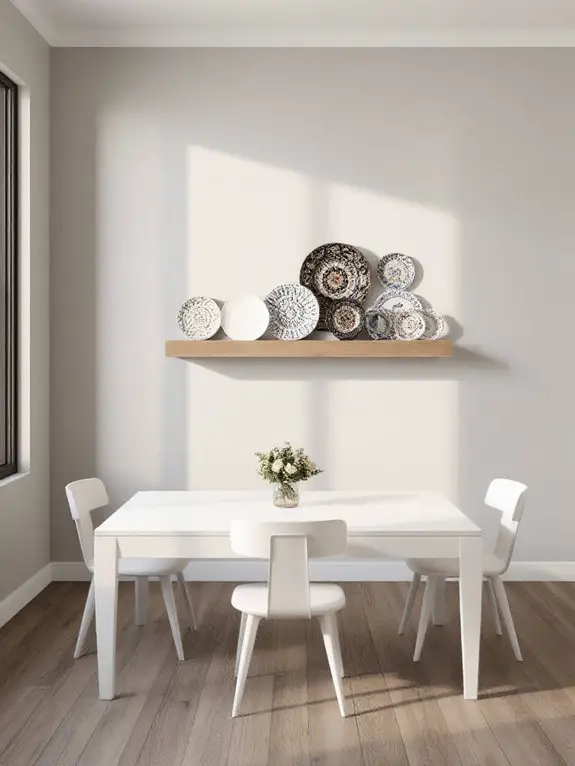
If you’re looking for a unique way to personalize your dining room, displaying a collection of plates can add charm and character to the space. I like to arrange them on a floating shelf, a plate rack, or even directly on the wall using plate hangers.
Mix and match patterns, sizes, and colors to create visual interest, but keep a cohesive theme, like vintage florals or bold modern designs.
Don’t overcrowd the display—leave some breathing room to let each piece shine. This approach not only showcases your personality but also turns your dining area into a conversation starter.
Swap Out Dining Chairs for Benches
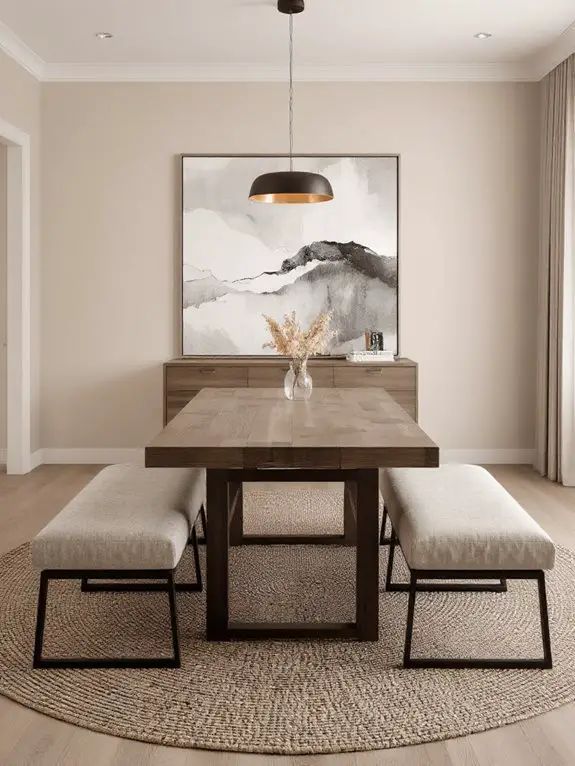
Replacing traditional dining chairs with benches can instantly refresh your space, offering both style and functionality. I’ve found that benches create a cozy, communal feel, making meals feel more intimate.
They’re perfect for small dining areas since they tuck neatly under the table, saving space. I love how versatile they are; I can pair them with chairs for a modern mix or use them alone for a streamlined look.
Opt for upholstered benches for added comfort or wooden ones for a rustic vibe. Plus, they’re great for families, as kids can easily slide in and out without moving chairs. It’s a simple yet impactful change.
Use Tiered Trays for Decor
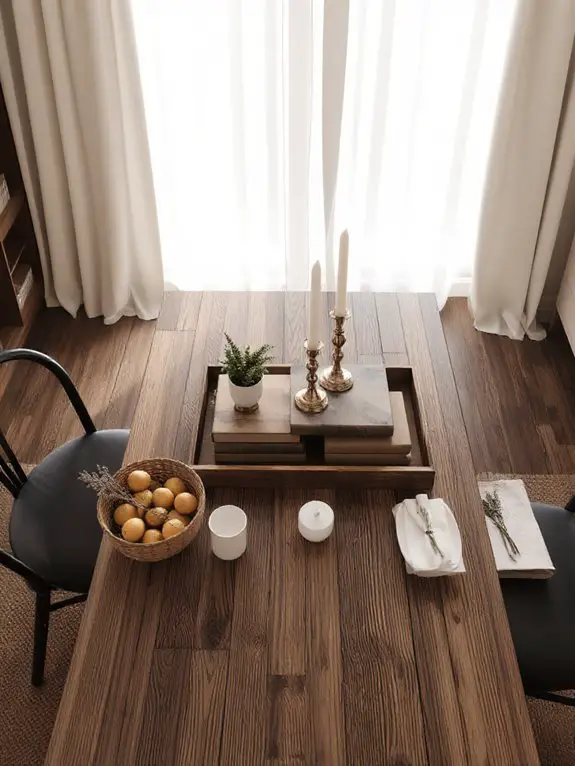
To add both style and functionality to your dining room, incorporating tiered trays can elevate your decor effortlessly. I love how they maximize vertical space while displaying small decor pieces, like candles or succulents, without cluttering surfaces.
Choose trays in materials like wood or metal to match your dining table’s aesthetic. Layer them with practical items—salt shakers, napkin rings, or fresh fruit—to blend form and function.
For a cohesive look, stick to a neutral palette or add pops of color with seasonal accents. Just keep arrangements balanced so they enhance, not overwhelm, your space. It’s a simple upgrade with big impact.
Incorporate Seasonal Decorations
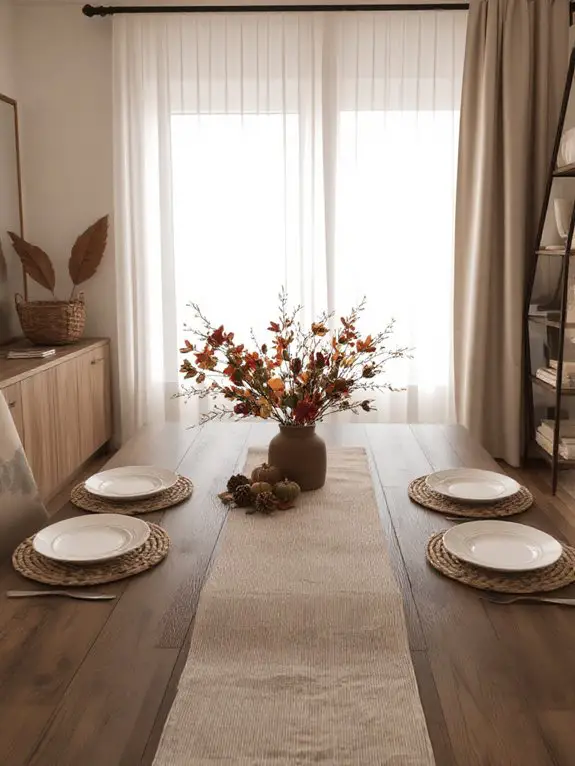
Seasonal decorations bring life to a dining room, offering an easy way to refresh the space throughout the year. I like to start with a neutral base—think tablecloths, placemats, and centerpieces—then layer in seasonal accents. In fall, I’ll add warm-toned candles, gourds, or dried foliage.
For winter, I swap in evergreen branches, twinkling lights, or metallic ornaments. Spring calls for fresh flowers or pastel-colored linens, while summer thrives with bright, lightweight fabrics and seashells.
I keep the changes subtle and cohesive, so my dining room feels intentional without overwhelming the space. It’s a simple, effective way to keep the room feeling current and inviting.
Create a Gallery Wall
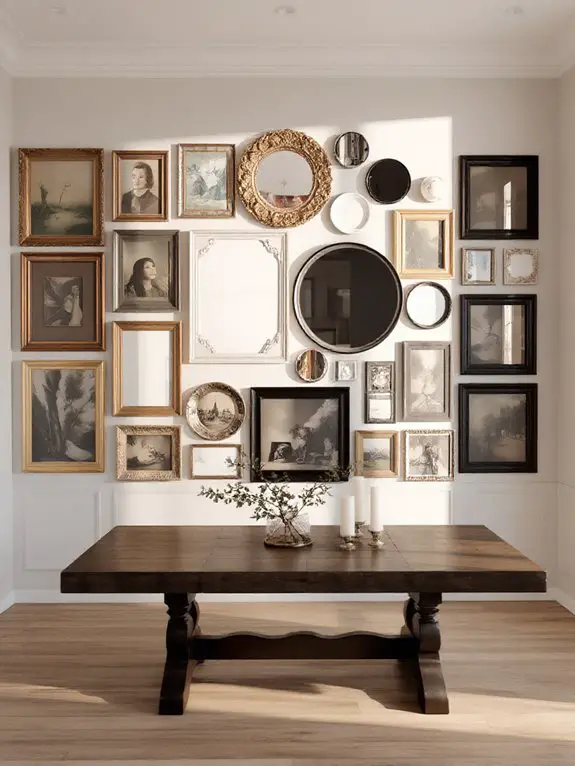
When I tackled creating a gallery wall in my dining room, I realized it’s a fantastic way to add personality and visual interest without overwhelming the space. I started by choosing frames that complemented my decor, mixing sizes and styles for variety.
To plan the layout, I arranged the frames on the floor first, ensuring balance and cohesion. I included a mix of family photos, artwork, and meaningful prints to tell a story about my home.
Positioning the wall at eye level made it more inviting. This project transformed my dining room into a curated, personalized space that guests always admire.
Add a Cozy Throw or Pillows
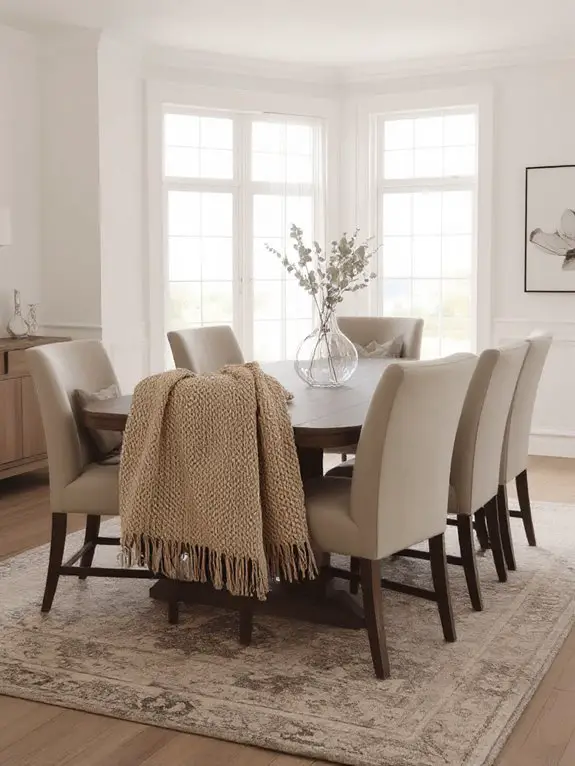
Though often overlooked, adding a cozy throw or pillows can instantly elevate the comfort and style of your dining room. I love draping a soft throw over dining chairs for a warm, inviting touch.
Choose materials like wool or cotton for durability and seasonal versatility. Pillows on benches or chairs add color and texture, making the space feel more relaxed.
Stick to neutral tones for a timeless look or bold patterns for a pop of personality. Keep them clean and wrinkle-free to maintain a polished appearance.
This simple addition can transform your dining area into a welcoming retreat without overwhelming the decor.
Use Candlelight for Ambiance
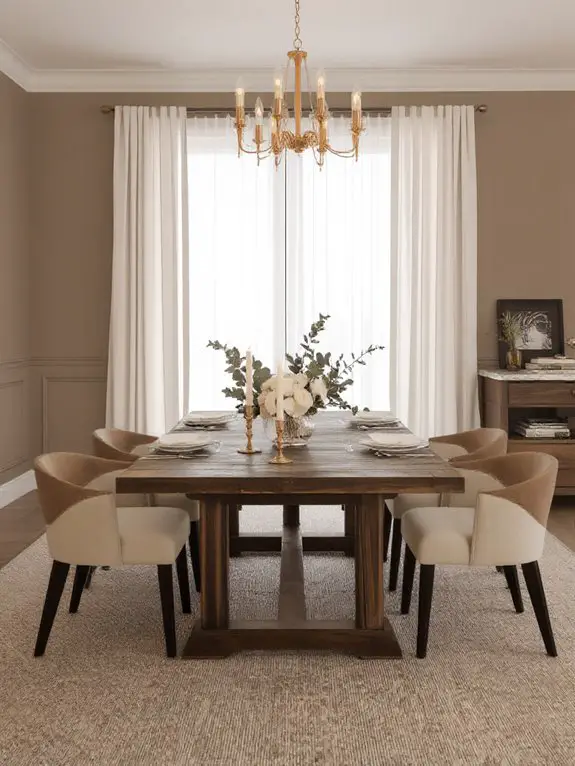
Candlelight offers a timeless way to enhance the atmosphere of your dining room, creating warmth and intimacy that’s hard to replicate. I love using tapered candles in elegant holders or clustering tea lights in glass votives for a soft glow. Unscented candles are my go-to to avoid overpowering food aromas.
For safety, I place them on stable surfaces away from flammable materials. Lanterns or hurricane lamps can add style while protecting the flame.
Adjusting the number of candles lets me control the brightness—perfect for romantic dinners or lively gatherings. It’s a simple yet impactful way to elevate the dining experience effortlessly.
Install Wainscoting or Wall Paneling
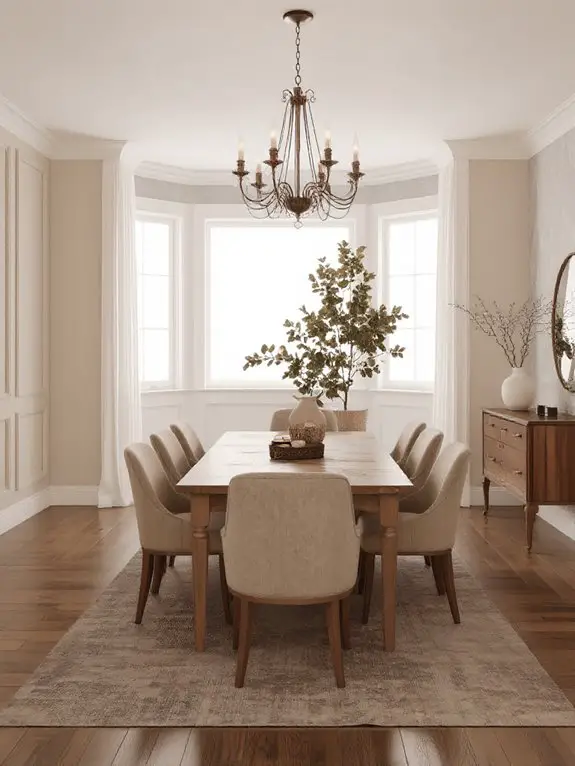
Adding wainscoting or wall paneling to your dining room can instantly elevate its elegance and character. I’d recommend choosing a style that complements your existing decor—whether it’s classic beadboard, sleek shiplap, or ornate raised panels.
Measure your walls carefully and mark the height before installing to guarantee consistency. Paint or stain the panels to match your color scheme, or leave them natural for a rustic touch.
This detail adds texture and depth, making the room feel more polished. It’s a relatively simple upgrade that packs a big visual punch, transforming plain walls into a focal point.
Introduce a Chandelier or Pendant Light
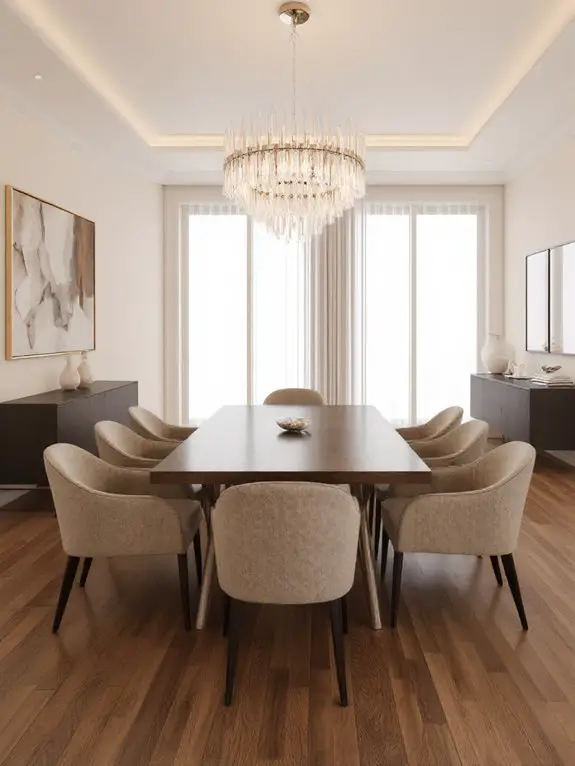
If you’re aiming to create a striking focal point in your dining room, a chandelier or pendant light can transform the space with both style and function. I always recommend selecting a fixture that complements your room’s scale—larger tables suit bigger, statement pieces, while smaller tables pair well with modest designs.
Consider the height too; hang it about 30 to 36 inches above the table for ideal illumination. Materials like metal, glass, or wood can tie into your decor theme. Dimmable lights are a smart choice, allowing you to adjust the ambiance for meals, gatherings, or casual evenings.
Use Decorative Placemats and Napkins
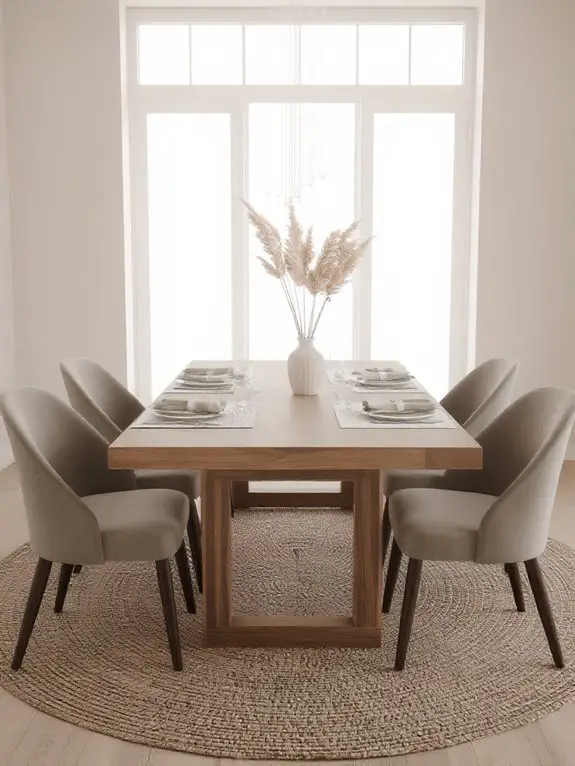
With lighting set as the focal point, it’s time to enhance your dining table’s surface with decorative placemats and napkins. I choose materials like linen, woven fabrics, or even eco-friendly options like bamboo to add texture and color.
Neutral tones create a timeless look, while bold patterns or seasonal hues can inject vibrancy. I make sure the placemats complement the table’s finish and the overall room decor.
For napkins, I fold them neatly or use elegant holders for a polished touch. By coordinating these elements, I transform the table into a cohesive, inviting space that feels both functional and stylish.
Add a Modern or Vintage Centerpiece
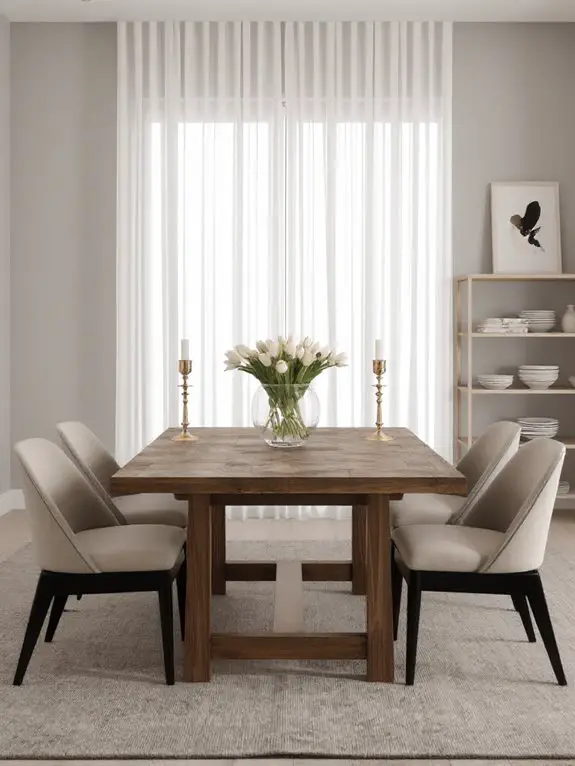
Though the dining table’s surface is already enhanced with placemats and napkins, I find that a centerpiece can truly anchor the space. A modern centerpiece, like a sleek glass vase with fresh flowers or a minimalist geometric sculpture, can add a polished, contemporary touch.
For a vintage vibe, I love using an antique tray with candlesticks or a rustic wooden bowl filled with seasonal fruits.
It’s essential to keep the centerpiece low and unobtrusive so it doesn’t block conversation. I also rotate items seasonally to keep the table feeling fresh and relevant to the time of year.
Paint or Refinish Your Dining Table
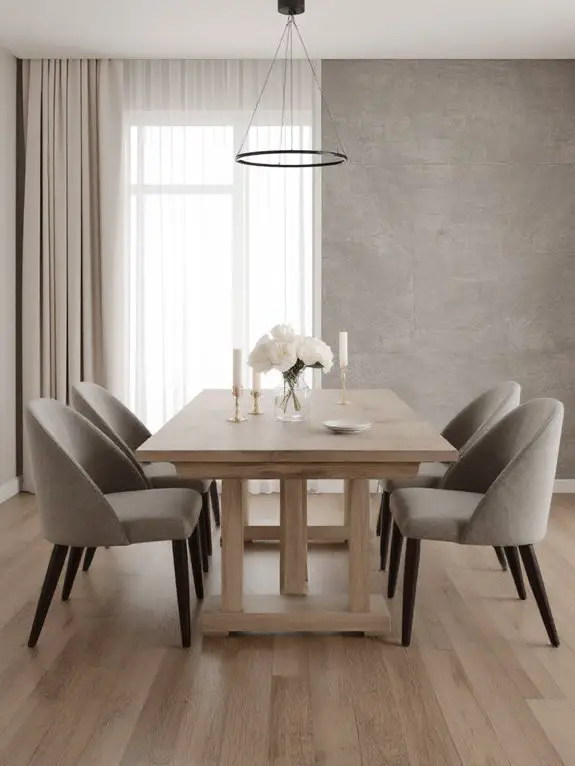
A well-chosen centerpiece can elevate your dining table, but the foundation—the table itself—deserves attention too. If yours looks worn or outdated, consider painting or refinishing it.
Sanding removes old finishes, while a fresh coat of paint in a bold hue can modernize it instantly. For wood tables, stain revitalizes the grain, adding warmth. Use a durable topcoat to protect against spills and scratches.
I’ve found that neutral tones keep the look timeless, but don’t shy away from color if it suits your style. Either way, this simple update transforms your table into a standout piece without breaking the bank.
Hang a Large Clock as a Focal Point
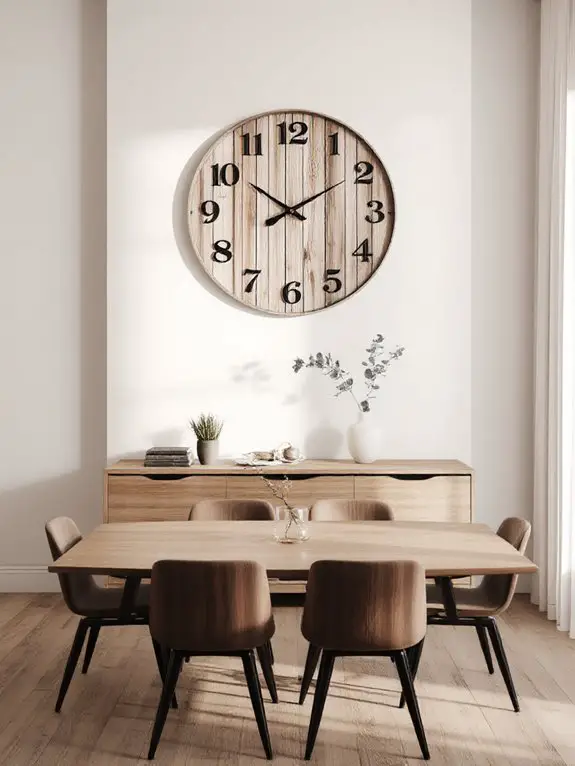
When updating your dining room decor, adding a large clock can serve as both a functional and decorative focal point.
I recommend choosing one with a bold design that complements your style—whether modern, farmhouse, or vintage. Position it above a buffet or opposite the dining table to draw the eye.
A clock not only keeps time but also adds symmetry and balance to the space. Opt for a silent mechanism to avoid distractions during meals.
If your walls are neutral, a metallic or wooden finish can add warmth. This simple upgrade elevates the room’s aesthetic while staying practical.
Frequently Asked Questions
How to Clean Dining Room Chairs?
I read that dining chairs can host up to 200 times more bacteria than a toilet seat! To clean mine, I wipe them with a damp cloth and mild soap weekly, vacuum fabric seats, and use a wood cleaner for wooden ones.
What’S the Best Dining Table Size for Small Spaces?
I’d recommend a table that’s 36-42 inches wide and seats 2-4 people for small spaces. A round or extendable table works best—it saves room and can adapt when I need extra seating for guests.
How to Protect a Wooden Dining Table?
I always use coasters for drinks and placemats for meals to prevent scratches and heat damage. I clean spills immediately and apply a wood-safe polish monthly. I also avoid direct sunlight to keep the finish from fading.
Can I Mix Different Dining Chair Styles?
I think mixing different dining chair styles works if they share a common element like color, material, or shape. I’d stick to a neutral palette or pair bold chairs with simpler ones for balance.
What’S the Ideal Dining Room Lighting Brightness?
I’d aim for around 300 to 500 lumens per square foot in my dining room. That’s bright enough for meals but still cozy. I’d use a dimmer switch to adjust it depending on the mood or occasion.

